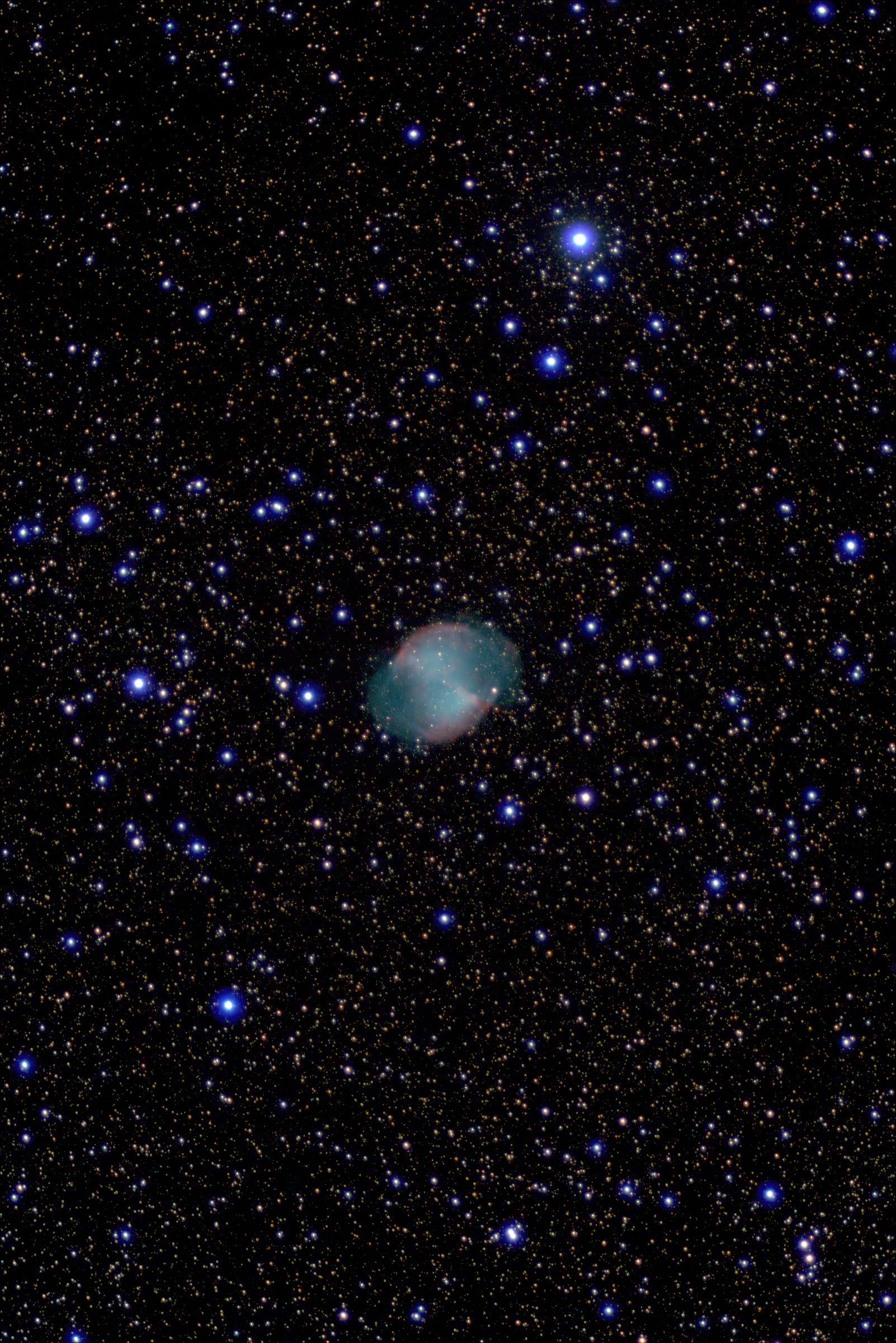Summer Sights for Balmy Nights
07 September 2021

Messier 27, the "Dumbbell Nebula", imaged 2021 September 4
with an Explore Scientific AR102 10.2-cm (4-inch) f/6.5 refractor
and a ZWO ASI183MC CMOS imager from Great Meadow, Old Tavern, Virginia
The Moon returns to the evening sky this week, emerging as a slender crescent in the southwestern sky on the evening of the 8th. On the evening of the 9th Luna will be a few degrees to the right of the brilliant glow of Venus. During the week the Moon skims the southern horizon and ends the week among the stars that form the “Teapot” asterism of Sagittarius. First Quarter occurs on the 13th at 4:39 pm Eastern Daylight Time.
The first full week of September finds the length of daylight dwindling by about 2.5 minutes per day. As the week opens Washingtonians experience 12 hours and 40 minutes between sunrise and sunset; in just over two weeks our days will become shorter than our nights. This, of course, is a boon to skywatchers, who now don’t have to wait until the late evening to enjoy fully dark skies. It’s a great time to enjoy the many wonders of the summer’s stars.
By 9:30 pm local time the season’s singular asterism, the Summer Triangle, lies directly overhead for most residents of northern temperate latitudes. The Triangle consists of the brightest stars in three separate constellations. The brightest of the three is Vega, which leads the diminutive constellation of Lyra, the Harp. Vega is located just 25 light-years from the solar system, and it is the fifth brightest star in the sky. Its brightness and proximity make it an ideal star for high-resolution spectroscopy, and it is arguably the most intensely studied star other than the Sun. It was the first star other than the Sun to be photographed back in 1850, and thanks to the precession of Earth’s rotational axis it will be the northern hemisphere pole star in about 12,000 years. Altair, the southernmost star in the Triangle, is even closer to us than Vega, a mere 16.7 light-years distant. Altair is noted for its exceptionally fast rotation rate, completing a single revolution in about 9 hours. In contrast, our Sun takes nearly 25 days to make one rotation. The third star in the Triangle is also its faintest, but not by much. Deneb is just over a magnitude fainter than Vega, but its actual luminosity belies its visual appearance. Deneb is much farther from us than its two bright companions, lying about 2500 light-years away. This means that it shines with the energy of around 200,000 Suns to appear as bright as it does in our sky.
Early in the week, when the Moon sets in the early evening, skywatchers in dark locations can see the soft glow of the Milky Way piercing the center of the Summer Triangle, then gently wafting down to the southern horizon to another signature summer asterism. This star pattern makes a credible outline of a teapot and consists of the brightest stars in the constellation of Sagittarius. Throughout the Milky Way a pair of binoculars or a small telescope will reveal bright and dark knots among the vast star clouds. Many of the brighter objects were first catalogued by the 18th Century French Astronomer Charles Messier, who made most of his discoveries from a hotel rooftop in Paris. Star charts of this area of the sky are littered with the “M” designation attached to his finds. Many of these objects are the spectacular targets of images from the Hubble Space Telescope. One of my favorites is an object located between Deneb and Altair in the very obscure constellation of Vulpecula, the Fox. Known as M27, it is a so-called “planetary nebula” produced when a low-mass star reaches the end stage of its evolution. Popularly called the “Dumbbell Nebula” due to its two-lobed visual appearance in small telescopes, its ghostly greenish glow reaches us from some 1400 light-years away.
Dazzling Venus graces the evening twilight in the southwestern sky, popping into view shortly after sunset. Often referred to as Earth’s “twin”, it is physically quite similar in mass and composition. However, the two planets are radically different. Venus has an atmosphere that consists almost entirely of carbon dioxide, which has caused a “runaway greenhouse” effect that heats the planet’s surface to a temperature that is hot enough to melt lead.
As evening twilight deepens, the solar system’s largest planets appear in the southeastern sky. Saturn shines with a gold-tinted hue well east of the “Teapot” asterism among the faint stars of Capricornus. Saturn’s distinctive rings make this one of the most enthralling sights in the sky. They are easily seen in small telescopes, and show more detail as you look with larger instruments.
Jupiter’s cheery glow follows Saturn across the sky. Binoculars will show the four bright moons discovered by Galileo in 1610, and a good three-inch telescope will show the planet’s dark equatorial cloud belts. If you have a six-inch or larger telescope you should be able to see many features in the planet’s clouds, including the famous Great Red Spot, an Earth-sized storm that has persisted for some 300 years. Look for the Spot on the evenings of the 7th, 9th, and 12th.